Chapter: Aquaculture Principles and Practices: Carps
Main species of carps (familyCyprinidae) used for culture - Aquaculture
Main species of carps (familyCyprinidae) used for culture
Common carp
Of all the species of finfish or shellfish used for aquaculture, carps undoubtedly have the oldest history. The common carp (Cyprinus carpio) is probably one of the few aquaculture species that can be considered to have been domesticated.
The common carp is presently cultured all over Asia, in most parts of Europe including the former USSR, and on a small scale in some countries of Africa and Latin America (particularly Brazil). It has also been introduced in North America and Australia. Though considered to be a sport fish as well, its main importance is as a food fish. In fact the prejudice towards common carp in some countries has been created by anglers who consider it a pest in sport waters, because it muddies the water when routing around for food on the margins and the bottom of water bodies.
There are three recognized varieties of common carp: the orange-coloured scale carp (C. carpio var. flavipinnis), the partially-scaled mirror carp (C. carpio var. specularis) and the virtually scaleless leather carp (C. carpio var. nudus). There is also a variety with only onerow of big scales on the lateral sides. The normally coloured or orange-coloured scale carp and the mirror carp are the varieties preferred for culture, mainly because of their faster growth rates (figs 16.1 and 16.2). Several races and strains of common carp have evolved or have been created through breeding programmes. A well-known race is the ‘big-belly’carp of China, which is a hardy fish that starts breeding at the early age of about six monthsand has relatively large gonads, which accounts for its name ‘big-belly’. The Japanese Yamato carp appears to be related to the Chinese big-belly. The Punten carp of Indonesia is a quick-growing race.
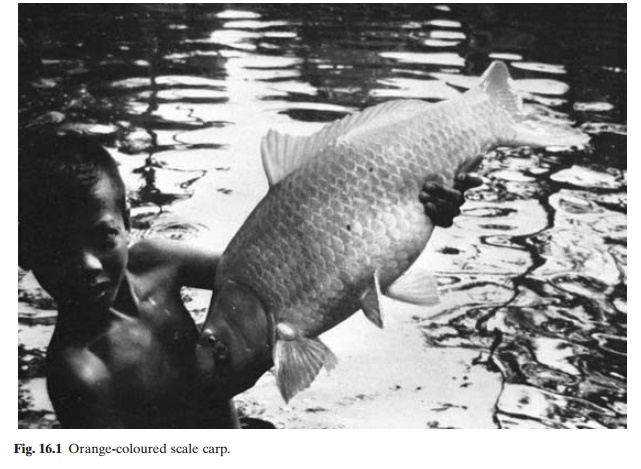
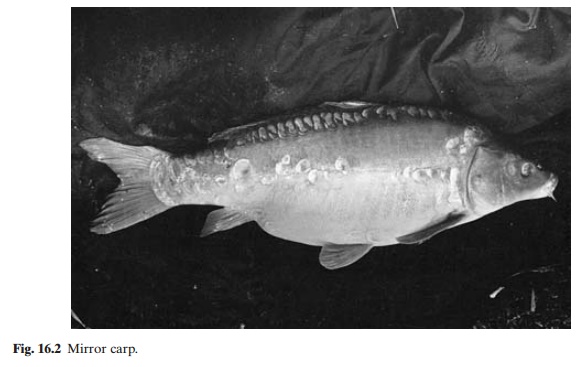
There are a number of other geographical races such as the Galician and Franconian races of the mirror carp and the Aischgrund carp of Germany and Royale of France. They are distinguished by their body form, particularly by the length/height ratio and body thickness. The main varieties cultured in the former USSR are the scale carp, the mirror carp (with scales scattered all over the body) and the Ukrainian frame carp (with scales framing the sides of the body). A number of breeds or strains of the common carp have been developed by genetic breeding in East European countries, especially in the former USSR, Hungary and in Israel.
Kirpichnikov et al. (1979) referred to local strains of the Ropsha scaly carp based on selection of hybrids between the Amur wild carp and Galician cultured carp and also the Ukrainian-Ropsha hybrid scaly carp, obtained through crossing the Ropsha carp with the Ukrainian ‘frame-scaly’ carp (fig. 16.3). Most of these strains have been developed for the purpose of improving the growth rate, suitability for the climatic conditions, time of maturation and spawning. Hungarian races of common carp have been crossbred to produce hybrids with improved egg fertility and increased growth with lower feed consumption (Bakos, 1979) (figs 16.4 and 16.5). Recently, a strain of common carp known as the Heyuan carp has been developed in China by crossing the female
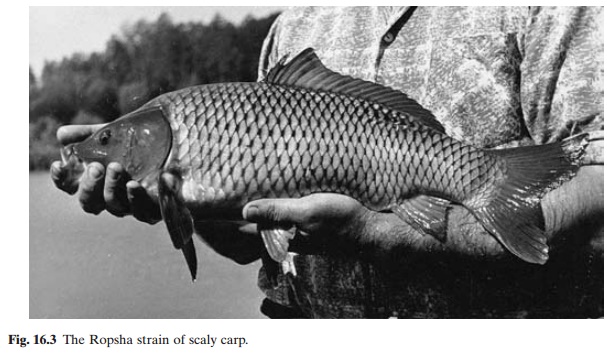
‘purse carp’ with the male ‘yuanjiang carp’. This hybrid strain is reported to grow faster (by over 30 per cent) than wild carp, is easy to catch, has a larger body weight and apparently greater disease resistance.
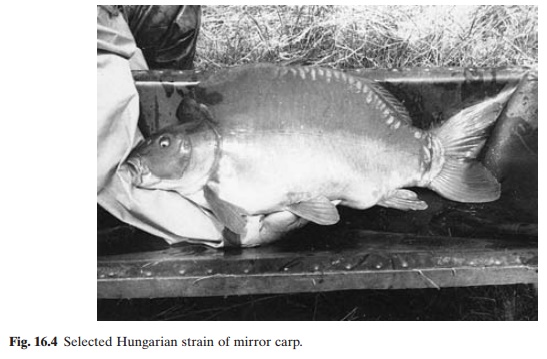
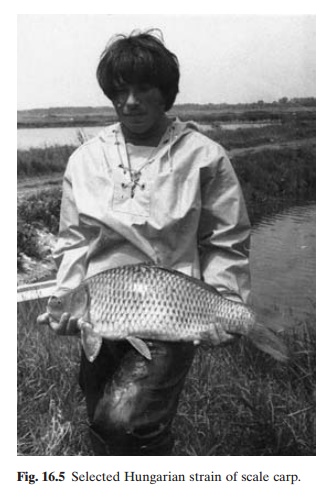
The common carp is an omnivore and in nature and in culture ponds it feeds on a wide variety of plant and animal matter. The young carp, up to a length of about 10cm, feed on protozoa and zooplanktonic organisms such as copepods and cladocerans. Above that size, they start feeding on benthic organisms, such as insect larvae (especially chironomid larvae), worms and molluscs, together with large quantities of vegetable matter and epiphytic organisms. The carp’s habit of sucking food organisms in the mud on the pond bottom and margins makes the water muddy and weakens the base of pond dikes. However, when fed on artificial feedstuffs or processed feeds, this habit is greatly curtailed.
Chinese carps
A group of carp that has become equally or more important in aquaculture consists of the five species popularly known collectively as the Chinese carps: the grass carp (Ctenopharyngodon idella) (fig. 16.6), the silver carp (Hypophthalmichthys molitrix) (fig. 16.7), the bighead (Aristichthys nobilis) (fig. 16.8), the black carp (Mylopharyngodon piceus) (fig.16.9) and the mud carp (Cirrhina molitorella).
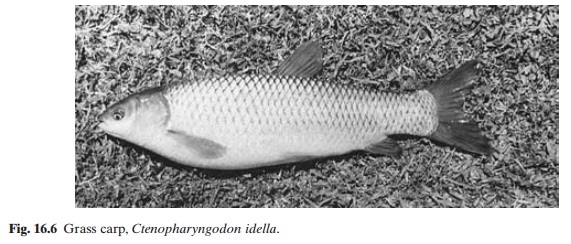
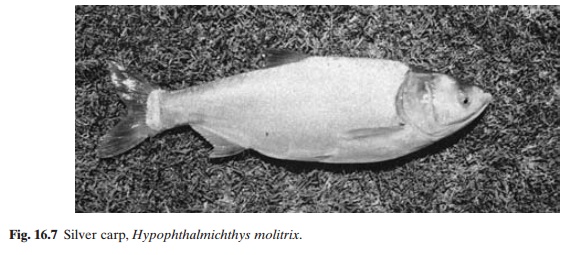
The historical reason for the origin of their culture in China has been mentioned.
It would appear that the very popular poly- culture system originated with the culture of these species. Since they do not spawn naturally in ponds, larvae and fry had to be collected from the natural spawning grounds in the rivers. It was not easy to sort young larvae com pletely, and so all the species had to be cultured together. Experience showed the compatibility of the species in ponds and the higher produc tion that the farmers could obtain by combined culture.
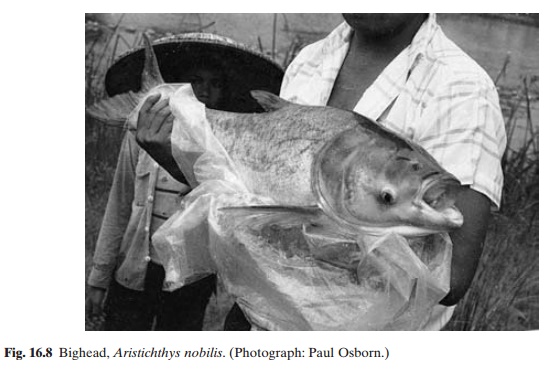
The grass carp is herbivorous and feeds on macrovegetation, including grass and aquatic plants; the silver carp feeds on plankton, mainly phytoplankton; the bighead consumes the macroplankton; and the black carp feeds on snails and other molluscs at the bottom. The mud carp feeds primarily on detritus. To this combination is added the omnivorous common carp, which the farmers consider a scavenger in the pond. The grass carp starts feeding on macrovegetation when about 2.5–3cm in length, and is reported to ingest up to 50 per cent of its weight in the form of land plants (Martyshev, 1983). It stops feeding at a temperature of 10–12°C; at temperatures above 20°C, it eats large amounts of grass. The silver carp starts feeding on algae at a length of about 1.5cm. It can feed on microscopic phytoplankton, as small as 30–40 mm, by filtering it through its very efficient gill rakers. The larvae of bighead feed on unicellular planktonic organisms.The fry and adults feed on both phyto- and zooplankton and thus compete to some extent with silver and common carps; however, the bighead generally prefers larger organisms. The
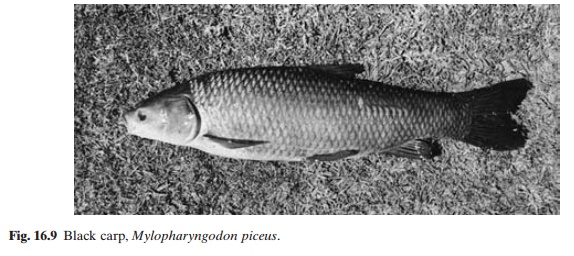
adult black carp feeds on benthic animals, but shows a special preference for molluscs.Though it is not considered a high-value fish outside China, it serves a specific role in controlling the growth of molluscs in polyculture ponds. Mud carp does not grow to a large size and is essentially a subtropical species, and so its use in polyculture is somewhat restricted, even though it is greatly esteemed by consumers.
Despite considerable interest in Chinese carps, their culture was restricted initially to only a few neighbouring countries with large Chinese populations, until methods of induced breeding were developed in China, the former USSR and India during the period 1960–62. Starting with the former USSR, most of the East European countries have made progress in the culture of these carps, known there as phytophagous or herbivorous carps. The more popular species have been the grass carp, because of its ability to control macrovegetation, and the silver carp, as it can utilize the dense blooms of phytoplankton. But the consumer preference continues to be for the common carp and countries like Hungary have depended on export markets in the Middle East for their production of silver carp. Many countries in Asia, some in the Middle East (particularly Israel and Egypt) and some countries in South and Central America (especially Mexico) have introduced Chinese carps for pond culture. The main interest in Western Europe and the USA has been in using the grass carp as a biological weed-control agent,
and the species has been introduced for this purpose. To prevent breeding of the species in weed-infested water bodies, efforts have been made to produce all-male grass carp by administration of methyltestosterone, with limited success (Stanley and Thomas, 1978).
Indian carps
A third group of carps is the Indian carps: catla (Catla catla) (fig. 16.10), rohu (Labeo rohita) (fig. 16.11), mrigal (Cirrhina mrigala) (fig. 16.12) and calbasu (Labeo calbasu). In India these species are referred to as the major carps, to distinguish them from a number of other cyprinids that grow only to smaller sizes, known as minor carps. For more or less the same reasons as the Chinese carps, these species have also been cultured together in traditional pond culture. Even though the farmers were able to spawn them in special ‘bundh’ types of ponds, most of the larvae and fry required for culture had to be collected from their natural spawning grounds in the rivers. It was extremely difficult to sort out the species at the early stages, and was easier to rear them together rather than separately. Addition of Chinese carps, such as grass carp, silver carp and common carp, to this combination resulted in higher yields than from polyculture of Indian carps only. This combination of Indian and Chinese carps is referred to as composite carp culture in India.
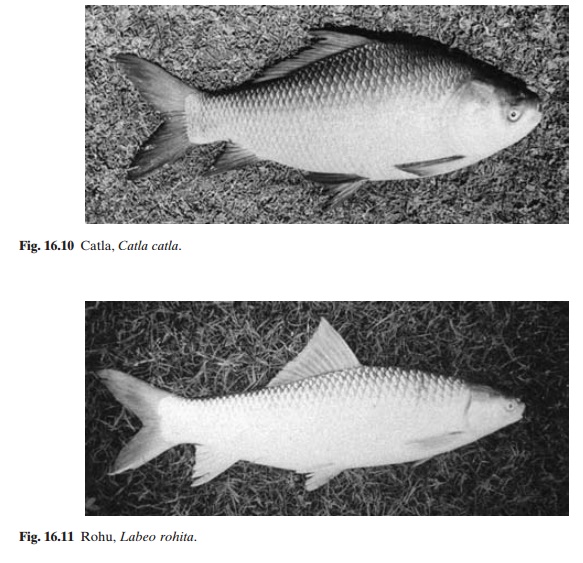
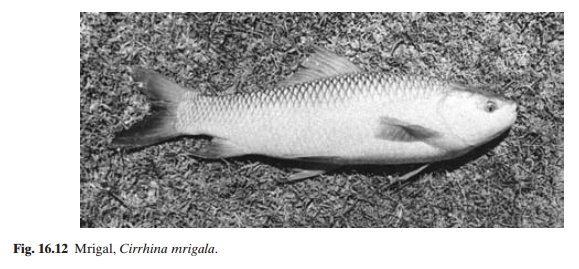
Catla is considered to be a surface and column feeder. Larvae and young fry feed on believed that some species feed on planktonic unicellular algae. After reaching a length of about 2 cm, the fry start feeding on zooplanktonic organisms, showing a preference for protozoans and crustaceans. The adults feed on different types of algae, planktonic protozoa, rotifers, crustaceans, molluscs and decayed macrovegetation. They show a specific preference for planktonic organisms. Rohu is a column feeder in ponds. Larvae and fry feed on unicellular algae and zooplanktonic organisms.
Adults feed on various types of vegetable matter including decaying aquatic plants, algae, etc. The adult mrigal is a bottom feeder. Larvae and fry have about the same feeding habits as the other Indian carps, but the adult fish feed on algae, diatoms, higher plants and detritus.
Calbasu is also a bottom feeder, feeding on benthic and epiphytic organisms and organic debris from the pond bottom. Larvae and fry feed on unicellular algae until they reach about 2cm, after which they prefer phyto- and zooplankton. The combination of surface, column and bottom feeding fish has been the basis of Indian carp culture. As indicated earlier, the Chinese silver carp and grass carp and the common carp have been included to improve production. Several ratios of these species have been tried in experimental stations, and it was reported that a combination of grass carp, catla, rohu and common carp gave the best results.
Species combinations
In both China and India, there is a trend towards increasing the number of species in pond polyculture for the purpose of higher production.While the value of combined culture of certain species in ponds under specific culture conditions is accepted, the general concept of exclusive ecological niches for each species of carp does not seem to hold, particularly in the context of the increasing number of species added to the combinations. There is considerable overlap in the feeding habits and spatial use of the ponds by the different species.
However, some of the species in the combinations can have specific roles in the maintenance of the oxygen regime and sanitary conditions in the ponds. For example, the silver carp can be of considerable value in controlling algal blooms and reducing oxygen consumption. Though not very clearly proved, it is generally believed that some species feed on the excreta of others and thus reduce the accumulation of organic matter on the pond bottom. As mentioned earlier, the common carp and mrigal are considered as scavengers in polyculture ponds as they may consume the faeces of the grass carp and the silver carp, which contain large amounts of undigested plant matter.
The above possible advantages have to be weighed against some of the requisites of poly-culture. The need to produce or purchase the required number of fry or fingerlings of a selected number of species and to maintain the balance of species in order to avoid competition calls for special care, skill and effort on the part of the farmer. It is not very easy to adopt supplemental feeding in an economical way. Additional labour would be involved in sorting out the different species after harvest. Consumer acceptance of the different species varies in most areas, and in fact difficulties have been experienced in finding markets for certain species such as the silver carp in some countries.
A critical analysis of the biological and economic aspects shows that the value of polyculture depends very much on the situation in a particular area, and is probably not so widely applicable as generally considered. It is necessary to compare the productivity and economics of monoculture of the more important species, before making decisions on extending species combinations.
Another cyprinid species that needs to be mentioned is the tench (Tinca tinca), which has been associated with common carp culture in Europe and introduced into upland areas of countries such as India many years ago. However, there is presently very little interest in its culture and it does not appear to figure prominently in aquaculture production.
Related Topics